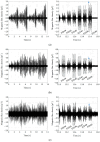Phantom-Based Approach for Comparing Conventional and Optically Pumped Magnetometer Magnetoencephalography Systems
- PMID: 40218576
- PMCID: PMC11991522
- DOI: 10.3390/s25072063
Phantom-Based Approach for Comparing Conventional and Optically Pumped Magnetometer Magnetoencephalography Systems
Abstract
Magnetoencephalography (MEG) is a vital tool for understanding neural dynamics, offering a noninvasive technique for measuring subtle magnetic field variations around the scalp generated by synchronized neuronal activity. Two prominent sensor technologies exist: the well-established superconducting quantum interference device (SQUID) and the more recent optically pumped magnetometer (OPM). Although many studies have compared these technologies using human-subject data in neuroscience and clinical studies, a direct hardware-level comparison using dry phantoms remains unexplored. This study presents a framework for comparing SQUID- with OPM-MEG systems in a controlled environment using a dry phantom that emulates neuronal activity, allowing strict control over physiological artifacts. Data were obtained from SQUID and OPM systems within the same shielded room, ensuring consistent environmental noise control and shielding conditions. Positioning the OPM sensors closer to the signal source resulted in a signal amplitude approximately 3-4 times larger than that detected by the SQUID-MEG system. However, the source localization error of the OPM-MEG system was approximately three times larger than that obtained by the SQUID-MEG system. The cause of the large source localization error was discussed in terms of sensor-to-source distance, sensor count, signal-noise ratio, and the spatial coverage provided by the sensor array of the source signal.
Keywords: dry phantom; magnetoencephalography; optically pumped magnetometers; superconducting quantum interference device.
Conflict of interest statement
The authors declare no conflicts of interest.
Figures















References
-
- Zhao B., Li L., Zhang Y., Tang J., Liu Y., Zhai Y. Optically Pumped Magnetometers Recent Advances and Applications in Biomagnetism: A Review. IEEE Sens. J. 2023;23:18949–18962.
Publication types
MeSH terms
LinkOut - more resources
Full Text Sources

